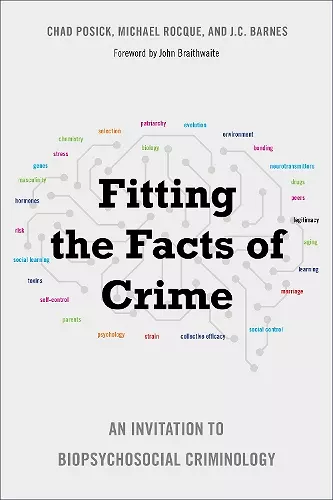Fitting the Facts of Crime
An Invitation to Biopsychosocial Criminology
Chad Posick author Michael Rocque author JC Barnes author
Format:Hardback
Publisher:Temple University Press,U.S.
Published:7th Jan '22
Should be back in stock very soon
This hardback is available in another edition too:
- Paperback£23.99(9781439919811)

Biosocial criminology—and biosocial criminologists—focuses on both the environmental and biological factors that contribute to antisocial behavior. Importantly, these two domains are not separate parts of an equation but pieces of the same puzzle that fit together for a complete picture of the causes of crime/antisocial behavior.
Fitting the Facts of Crime applies a biopsychosocial lens to the “13 facts of crime” identified by John Braithwaite in his classic book, Crime, Shame and Reintegration. The authors unpack established facts—about gender and sex, age, environment, education, class, social bonds and associations, stress, and other influences—providing both empirical research and evidence from biopsychosocial criminology to address the etiology behind these facts and exactly how they are related to deviant behavior.
With their approach, the authors show how biopsychosocial criminology can be a unifying framework to enrich our understanding of the most robust and well-established topics in the field. In so doing, they demonstrate how biological and psychological findings can be responsibly combined with social theories to lend new insight into existing inquiries and solutions. Designed to become a standard text for criminology in general, Fitting the Facts of Crime introduces key concepts and applies them to real-world situations.
"Biology and environment interact to direct human behavior. Crime is no exception. This comprehensive introduction, cleverly organized around Braithwaite’s facts of crime, describes how biological explanations can be integrated with social and psychological explanations to explain offending and to provide a more productive response to it from the criminal justice system. The authors provide a persuasive, balanced, and clear presentation and support it with current real-world examples. The result is an approachable introduction that provides a meaningful organizing framework for understanding crime from an interdisciplinary perspective that includes biology."—William Alex Pridemore, SUNY Distinguished Professor, School of Criminal Justice, University at Albany–SUNY
"A key takeaway from this book is that biological and sociological perspectives are complementary and not competing. Fitting the Facts of Crime will hopefully serve to further open the minds of criminologists to the importance of biology, as well as to ease tensions between more fundamentalist biological and sociological schools of thought. Because of how contentious some debates in this area can be, it is important for a book like this to present information in a neutral, non-defensive way, and to hold the audience from both sides. The authors have successfully accomplished this."—Jillian J. Turanovic, Associate Professor in the College of Criminology and Criminal Justice at Florida State University, and coauthor of Thinking about Victimization: Context and Consequences
"The main contribution of the book is to adapt some of the facts of criminology that have been accepted for more or less 30 years to the present day.... One of the most important conclusions of the book is that biological and sociological perspectives are complementary. Fitting the Facts of Crime brings criminologists together with biology. Although biopsychosocial criminology is not a theory in its own right, the empirical findings in the field are efficiently explained in the book."—Contemporary Sociology
"The authors clearly have a rich knowledge and appreciation of multiple ways of understanding crime, law, social control, and their underlying assumptions. Undoubtedly, there will be much resistance to, and criticisms of, the arguments presented throughout this innovative monograph, especially in sociological circles. However, increasingly, open-minded criminologists from different theoretical backgrounds are sincerely attempting to cross-fertilize, and this book will give them additional motivation to stay the course. Summing Up: Highly recommended."—W. S. DeKeseredy, Choice
"Overall, this book is a wonderful introduction to those interested in a biopsychosocial approach because it is accessible and well-organized. It makes solid connections between traditional theories and newer biopsychosocial theories, as well as emphasizes that criminal behavior is not just the result of social factors or biological factors alone but a combination of both. Anyone in the criminology and criminal justice field would benefit from reading this book to expand their existing knowledge of how integrating a biopsychosocial approach can provide a broader understanding of criminal behavior and crime in general."—Criminal Law and Criminal Justice Books
ISBN: 9781439919804
Dimensions: 210mm x 140mm x 13mm
Weight: unknown
230 pages